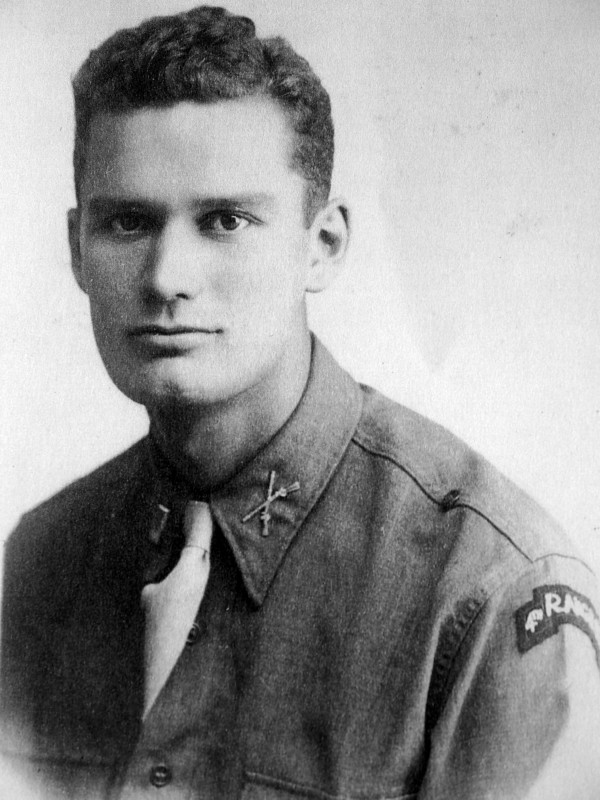Search Registry
Disclaimer: Information in the Registry is unofficial and not intended as a substitute for any official government record of military service.
Donald S. Frederick |
|
| Born | 1923, Albert Lea, Minnesota |
| Gender | Male |
| Parents | |
| Schools Attended | Minneapolis Central High School |
| Branch of Service | Army |
| Additional Identifiers | Non-commissioned Officer Commissioned or Warrant Officer National Guard Prisoner of War |
| Service Timeframe | 1939 - 1952 |
| War/Conflict | World War Two 1939-1945 Korean War 1950-1953 |
| Principal Units and Locations | 151st Field Artillery Regt., 34th Inf Div; 175th Field Artillery Bn, 34th Inf Div; First Ranger Battalion (Darby's Rangers); 47th Infantry Div. |
| Military Awards and Decorations | |
 Don Frederick in Italy shortly after receiving his promotion to lieutenant in October 1943. | |
NarrativeDon Frederick was born in Albert Lea, Minnesota, and moved with his family to Minneapolis when he was 14. In 1939, while still a student at Minneapolis Central High School, he joined F Battery, 151st Field Artillery, 34th Infantry Division, of the Minnesota National Guard and drilled at the downtown Minneapolis Armory (he remembered being paid $1 for a four-hour weekly drill, which was a good wage for a 16 year old in 1939). With war looming on the horizon, the Minnesota National Guard was ordered to active duty in the fall of 1940 for a year of “precautionary training,” and Frederick departed with his unit on 10 February 1941 for Camp Claiborne, Louisiana. As the year of training neared its end, Pearl Harbor was attacked and the United States officially entered World War Two. All enlistments were extended for the war’s duration. The 34th Division was reorganized and Frederick was transferred into the division’s new 175th Field Artillery Battalion. In January 1942 he sailed with the 175th to Northern Ireland, becoming part of the first contingent of American soldiers to be sent overseas for the European Theater. While training in Northern Ireland that spring, Frederick volunteered for—and was accepted into—a new U.S. Army unit. It was called the First Ranger Battalion and was patterned after the commando units of the British Army. The unit acquired the nickname “Darby’s Rangers,” after its hard-driving commander, Captain William Darby. Frederick’s training under Darby continued until late October 1942, when the Rangers began gearing up for the invasion of North Africa. On 8 November 1942 he was part of a combat force that assaulted the beach at Arzew, west of Oran, Algeria, and he participated in all the Ranger actions in the Tunisian Campaign until the Axis surrender of North Africa in May 1943. He then transferred to the newly formed 4th Ranger Battalion. Suffering from jaundice, he did not participate in the invasion of Sicily, but he went AWOL from the hospital in order to rejoin his battalion buddies in Sicily. That summer he was promoted to First Sergeant. In September he participated in the invasion of Italy, landing with the 4th Rangers north of Salerno at Maiori. In late October he received a battlefield commission and became a Second Lieutenant. On 4 November 1943, Frederick was captured and taken prisoner while leading a patrol across the Volturno River to Mt. Cesima above the town of San Pietro, which was deep behind German lines. After a month of interrogation in Berlin, he was sent to Oflag 64 (Officer POW Camp 64) in Szubin, Poland. There he remained a prisoner until January 1945 when, due to advancing Soviet troops, he and 1500 other American POWs were force marched 450 miles across the snow-swept, bitterly cold countryside to Oflag XIII-B POW Camp near Hammelburg, Bavaria, Germany. In March 1945, the camp was liberated for a day by General George Patton’s ill-fated Task Force Baum, which was drawn from the 4th Armored Division, but the Task Force was unable to return to friendly lines and Frederick was recaptured the next day. He was then moved to the huge Stalag VII-A POW Camp at Moosburg, Bavaria, where, as the European war came to an end, he was finally liberated in early May by men of the 14th Armored Division. Upon returning to the US, he married, had children, entered the hardware business, and moved to Iowa. He rejoined the National Guard, serving as a platoon leader in the 47th Infantry Division’s Reconnaissance Company, and had to return to active duty in January 1951 when the 47th Division was federalized for the Korean War. He was discharged in 1952 and eventually moved his family to Richfield, Minnesota, where he lived for the rest of his life. He was active in Ranger veterans’ organizations. Lieutenant Frederick passed away on 10 September 2010 and is buried at Fort Snelling National Cemetery. | |
